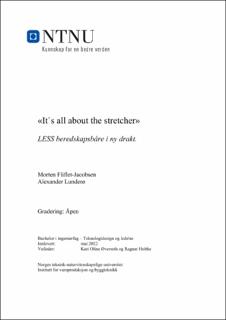| dc.contributor.advisor | Holthe, Ragnar | |
| dc.contributor.advisor | Øverseth, Kari Oline | |
| dc.contributor.author | Fliflet-Jacobsen, Morten | |
| dc.contributor.author | Lunderø, Alexander | |
| dc.date.accessioned | 2022-07-12T17:19:35Z | |
| dc.date.available | 2022-07-12T17:19:35Z | |
| dc.date.issued | 2022 | |
| dc.identifier | no.ntnu:inspera:106261165:112090452 | |
| dc.identifier.uri | https://hdl.handle.net/11250/3004808 | |
| dc.description.abstract | Formålet med dette prosjektet har vært å undersøke alternative materialer som evakueringsbåren til LESS kan produseres i, og hvilke produksjonsmetoder den kan produseres med.
Metodene som ble brukt for å undersøke dette begynte med en utforming av krav om hvilke egenskaper båren må ha. Det ble så brukt ulike metoder for å analysere det gamle produktet og komme frem til nye erstatningsmaterialer. For å eliminere bort alternativ ble materialene satt opp mot kravene og det ble gjort fysiske forsøk av forskjellige egenskaper.
Resultatene fra testene viste at de to termoplastene polypropylen og polyetylen var de plasttypene som egnet seg best. Det ble gjort datainnhenting om disse og prisen til polyetylen er billigere enn polypropylen. Dette la grunnlag for å konkludere med at polyetylen er et bra resirkulerbart alternativ for båren. Måten det skal produseres er ikke mulig å konkludere med da det krever oversikt over kompetansen og kapasitet hos fabrikker i Norge. Det er fordi materialet og produktet er mulig å lage med alle de nevnte metodene i denne oppgaven. Det er derfor behov for videre undersøkelse for å kunne konkludere med en produksjonsmetode. | |
| dc.description.abstract | The goal for this project has been to explore alternative materials for production of the emergency stretcher from LESS, and also what production method is the most suitable.
The methods used in the study began with defining the required traits that the stretcher needs to have. Following this, other methods were used to analyze the former version of the product, and to find new materials that could replace the old composition. The materials were then compared by traits and eliminated based on the requirements and physical testing of the different traits.
Results from testing showed that the two thermoplastics polypropylene and polyethylene were the most suitable materials. Based on research, the price of polyethylene was lower than the price of polypropylene. Because of this it was concluded that polyethylene is the best recyclable alternative. There is no conclusion on the production method, because this requires an overview of the competency and capacity of factories in Norway. It would be possible to produce the product in the new material with all the mentioned methods in the project. Because of this further research is needed. | |
| dc.language | nob | |
| dc.publisher | NTNU | |
| dc.title | LESS beredskapsbåre i ny drakt | |
| dc.type | Bachelor thesis | |
